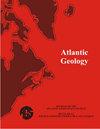加拿大新不伦瑞克省中央深部带中部花岗质岩石年代学和岩石地球化学:对Sn-W-Mo勘探的意义
IF 0.9
4区 地球科学
Q2 GEOLOGY
引用次数: 17
摘要
新不伦瑞克省中央深部岩体带的中部为大量侵入寒武纪至早奥陶世变质沉积岩的钙碱性、片理和非片理花岗岩岩体。U-Pb(锆石)测年表明,花岗岩的年龄范围为中奥陶世至晚泥盆世,但大部分为晚志留世至早泥盆世。McKiel湖花岗岩的年龄为467±7 Ma,而非叶理岩体的年龄为423.2±3.2 Ma (Bogan Brook花岗闪长岩)、420.7±1.8/-2.0 Ma (Nashwaak花岗岩)、419.0±0.5 Ma (Redstone Mountain花岗岩)、416.1±0.5 Ma (Beadle Mountain花岗岩)、415.8±0.3 Ma (Juniper Barren花岗岩)、409.7±0.5 Ma (Lost Lake花岗岩)和380.6±0.3 Ma (Burnthill花岗岩)。所有岩体均表现出弧状和板内混合地球化学特征,但红石山和burnhill花岗岩以板内型为主。微量元素数据显示,奥陶系和志留系—泥盆系岩体在整体地球化学上具有密切的相似性,表明它们都是由同一地壳源的部分熔融作用产生的。晚志留世至早泥盆世岩体主要由黑云母和/或含白云母的过铝质花岗岩组成,被认为是嗜花岗元素成矿的远景区。所有岩体的锡含量都远远超过花岗岩的全球平均丰度,其中一些岩体的锡含量与其他地方的生产性含锡花岗岩相当。Burnthill花岗岩、Lost Lake花岗岩、Beadle Mountain花岗岩和Nashwaak花岗岩在地球化学上的演化和富集程度最高,特别是Burnthill花岗岩经历了晚期热液作用,导致这些元素在局部富集。本文章由计算机程序翻译,如有差异,请以英文原文为准。
Geochronology and lithogeochemistry of granitoid rocks from the central part of the Central plutonic belt, New Brunswick, Canada: implications for Sn-W-Mo exploration
The central part of the Central plutonic belt in New Brunswick is underlain by numerous plutons of calc-alkaline, foliated and unfoliated granite that intrude Cambrian to Early Ordovician metasedimentary rocks. U-Pb (zircon) dating demonstrates that granites range in age from Middle Ordovician to Late Devonian, although most are late Silurian to Early Devonian. An age of 467 ± 7 Ma has been obtained on the foliated McKiel Lake Granite, whereas unfoliated intrusions yield ages of 423.2 ± 3.2 Ma (Bogan Brook Granodiorite), 420.7 +1.8/-2.0 Ma (Nashwaak Granite), 419.0 ± 0.5 Ma (Redstone Mountain Granite), 416.1 ± 0.5 Ma (Beadle Mountain Granite), 415.8 ± 0.3 Ma (Juniper Barren Granite), 409.7 ± 0.5 Ma (Lost Lake Granite), and 380.6 ± 0.3 Ma (Burnthill Granite). All plutons exhibit mixed arc-like and within-plate geochemical signatures, although the Redstone Mountain and Burnthill granites are dominantly of within-plate type. Trace element data reveal a close overall geochemical similarity between Ordovician and Silurian – Devonian plutons, indicating that all were generated by partial melting of the same crustal source. Late Silurian to Early Devonian plutons mainly comprise biotite and/or muscovite-bearing, peraluminous granite and are considered prospective for granophile-element mineralization. All plutons contain Sn well in excess of the granite global average abundance, and several contain average tin values comparable to productive stanniferous granites elsewhere. The Burnthill, Lost Lake, Beadle Mountain, and Nashwaak granites are geochemically most evolved and enriched in Sn and W. The Burnthill Granite in particular has experienced late-stage hydrothermal processes that have resulted in local enrichments of these elements.
求助全文
通过发布文献求助,成功后即可免费获取论文全文。
去求助
来源期刊

Atlantic Geology
GEOLOGY-
CiteScore
2.10
自引率
18.80%
发文量
0
审稿时长
>12 weeks
期刊介绍:
Atlantic Geology (originally Maritime Sediments, subsequently Maritime Sediments and Atlantic Geology) covers all aspects of the geology of the North Atlantic region. It publishes papers, notes, and discussions on original research and review papers, where appropriate to the regional geology.
 求助内容:
求助内容: 应助结果提醒方式:
应助结果提醒方式:


